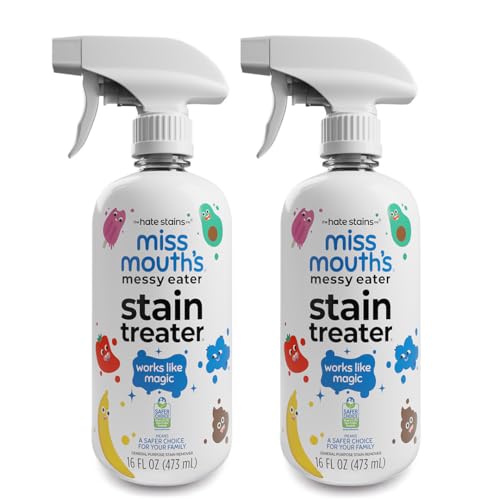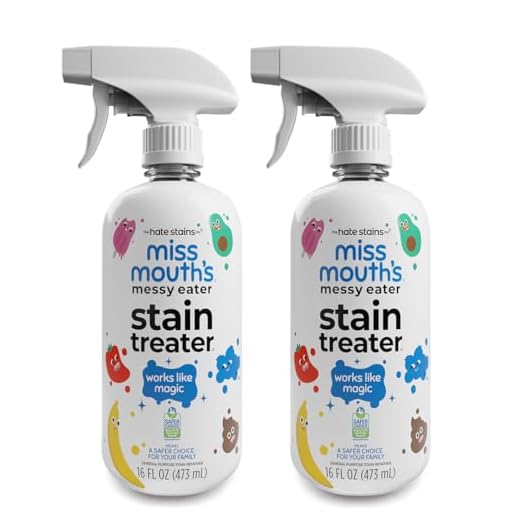

Immediately blot the affected area with a clean cloth or paper towel, absorbing as much of the liquid as possible without rubbing. This prevents the stain from setting deeper into the fibers. After the initial blotting, apply cold water gently to the stain, continuing to blot until the color begins to lift.
Next, a mixture of dish soap and hydrogen peroxide in equal parts can be applied directly to the mark. Let it sit for about 30 minutes, allowing the solution to break down the pigments. Rinse thoroughly with cold water afterward.
If the stain persists, a specialized stain remover designed for delicate fabrics may be necessary. Follow the instructions on the product carefully and perform a patch test on an inconspicuous area to ensure no damage occurs. Always wash the garment in cold water after treatment to prevent any remaining residue from setting.
Removing Stains from Fabrics
Immediately blot the impacted area with a clean cloth or paper towel to absorb excess liquid. Avoid rubbing, as this can set the stain deeper into the fibers. After blotting, sprinkle salt over the stain; this helps to absorb the remaining moisture. Allow it to sit for several minutes before gently brushing it off.
Alternative Solutions
A mixture of club soda and water can be applied next. Pour a small amount onto the stained area and blot again. This method lifts the color from the fabric. For persistent marks, consider a solution of hydrogen peroxide and dish soap in equal parts. Apply it to the area, wait for about 30 minutes, then rinse thoroughly with cold water.
Acting Quickly: Immediate Steps to Take
Blot the stain with a clean cloth or paper towel to absorb as much liquid as possible. Avoid rubbing, as this can spread the pigment further into the fibers. After blotting, sprinkle salt generously over the area. The salt acts as an absorbent, drawing the color out of the fabric.
Next, pour club soda or sparkling water onto the stained area. The carbonation helps lift the coloration from the fibers. Let it sit for a few minutes before blotting again with a clean cloth. Repeat this process as needed until the stain starts to fade.
If available, apply a stain remover directly to the affected area. Allow it to sit according to the manufacturer’s instructions, then rinse with cold water. Always check the fabric care label to ensure compatibility with your chosen cleaning products.
After treatment, launder the garment in cold water. Hot water can set the stain, making it more difficult to remove. Avoid drying until confident the discoloration is completely gone, as heat can also set remnants.
Choosing the Right Cleaning Solutions
For effective removal of stains from fabric, a couple of solutions stand out. Consider using club soda, which contains carbonation that helps lift the pigment from fibers. Apply it directly on the mark and blot gently with a clean cloth.
Another option involves a mixture of hydrogen peroxide and dish soap. Combine equal parts and apply to the affected area. This blend works well for breaking down color compounds. Allow it to sit for a brief period before rinsing.
Enzymatic cleaners, specifically designed for organic stains, can also be beneficial. Look for products that target tannins and pigments. Always conduct a patch test on an inconspicuous area to ensure no damage occurs to the fabric.
White vinegar diluted with water serves as a natural alternative; it neutralizes odors and helps lift stains. Mix one part vinegar with two parts water, apply, and gently blot.
For convenience, pre-packaged stain removers designed for fabric may provide quick solutions. Ensure the product is safe for the specific material before application.
Always follow the manufacturer’s instructions when using any cleaning agents and act swiftly for the best results. Patience and care in treatment can significantly improve outcomes.
Home Remedies: Natural Approaches to Stain Removal
For immediate action, sprinkle table salt on the affected area to absorb the liquid. Allow it to sit for a few minutes before gently blotting with a clean cloth. This method not only lifts stains but also minimizes the risk of spreading.
Another effective solution is to mix equal parts of baking soda and water to create a paste. Apply this paste directly to the mark and let it dry before rinsing with cold water. This natural abrasive helps to break down pigments effectively.
Utilizing white vinegar can also yield positive results. Pour a small amount onto the stain, followed by a sprinkle of baking soda. The fizzing reaction helps to lift the discoloration. Rinse thoroughly after a few minutes.
Lemon juice can act as a natural bleaching agent. Apply it directly to the stain and expose it to sunlight for a few hours. Rinse with cold water to see an improvement in the fabric’s appearance.
For a unique twist, consider using club soda. Pour it directly onto the mark and blot with a clean cloth. The carbonation can help lift the stain, making it easier to clean.
After trying these remedies, if you’re interested in culinary adventures, check out this guide on how to cook abalone hong kong style.
Using Professional Products: What to Look For
Focusing on specialized stain removal products can significantly enhance the chances of eliminating unwanted marks from fabric. Seek out solutions specifically designed for tackling deep-set stains, particularly those from beverages.
- Enzyme-based cleaners: These products break down organic compounds found in stains. Look for those formulated to target tannins and pigments.
- Oxygen bleach: This is a gentler alternative to chlorine bleach, perfect for maintaining the integrity of delicate fabrics while effectively lifting discolorations.
- Stain removers with surfactants: Surfactants help break the surface tension of the stain, allowing it to be more easily lifted away from fibers.
- Spot treatment sprays: These convenient options allow for targeted application on affected areas, ensuring that only the stained portion is treated.
Verify the product’s compatibility with specific fabric types. Always conduct a patch test in an inconspicuous area to prevent damage or discoloration. Following the manufacturer’s instructions is key for optimal results.
In addition to stain removers, consider pre-treatment solutions that can enhance the effectiveness of your main cleaning agent. These often provide an extra layer of protection against stubborn marks.
Lastly, check for customer reviews and ratings. Feedback from others can guide choices, ensuring the selection of a product that has proven effective in similar situations.
Preventing Future Stains: Tips for Wine Drinkers
Always opt for darker or patterned attire when enjoying beverages that can stain. This simple choice can save you from potential mishaps. If wearing lighter clothing, consider using a stain-resistant fabric treatment before the occasion.
Keep a small kit handy for emergency situations. Include items like club soda, a small bottle of white wine, and paper towels. Quick access to these can help mitigate damage before it sets in.
Mindful Drinking Practices
Use a wine glass with a larger bowl to minimize spills. Holding the glass by the stem rather than the bowl also reduces the chance of accidental dribbles onto clothing.
Practice pouring carefully. Tilt the bottle slightly and pour over the edge of the glass to control the flow and avoid splashes. If possible, place a napkin under the bottle’s spout to catch drips.
Educating Guests
When hosting, inform your guests about potential risks. Encourage them to be cautious, especially if they are using new glassware or unfamiliar with wine etiquette.
Provide coasters or trivets to protect surfaces from spills. This not only helps with furniture but also serves as a reminder to be careful while enjoying drinks.
FAQ:
What is the best way to treat a red wine stain on a white shirt?
The best method to treat a red wine stain on a white shirt involves acting quickly. First, blot the stain gently with a clean cloth to absorb excess wine. Avoid rubbing, as this can spread the stain. Then, sprinkle salt on the stain, which can help absorb the wine. After a few minutes, rinse the area with cold water. You can also apply a mixture of hydrogen peroxide and dish soap (in equal parts) to help lift the stain, letting it sit for about 30 minutes before washing the shirt in cold water.
Can I use white wine to remove red wine stains from my shirt?
Yes, white wine can be used as a home remedy to help remove red wine stains. Pouring white wine over the red wine stain can help dilute the pigments that cause the discoloration. After applying white wine, blot the area with a clean cloth and then treat the stain with a mixture of hydrogen peroxide and dish soap, followed by a rinse in cold water. Keep in mind that this method may not work for all fabrics, so it’s advisable to test it on a small, inconspicuous area first.
Is it possible to remove a red wine stain after it has dried?
Removing a dried red wine stain can be more challenging, but it’s not impossible. Start by rehydrating the stain with cold water, then apply a stain remover specifically designed for wine stains or a mixture of baking soda and water to create a paste. Apply the paste to the stain and let it sit for about an hour before rinsing it off. You may need to repeat the process several times for stubborn stains. Finally, wash the shirt in cold water and check if the stain is completely gone before drying.
What household items can I use to remove red wine stains?
Several household items can be effective in treating red wine stains. Common options include salt, baking soda, white vinegar, and club soda. Salt can absorb the wine when sprinkled on a fresh stain. Baking soda mixed with water can create a paste that helps lift the stain. White vinegar can neutralize the stain when mixed with dish soap, while club soda can help lift the wine’s pigments. Always remember to blot instead of rubbing to prevent spreading the stain.
Should I wash the shirt before treating the stain?
No, it’s generally not advisable to wash the shirt before treating the stain. Washing can set the stain, making it harder to remove. Instead, treat the stain as soon as possible by blotting it and applying your chosen stain removal method before washing. Once the stain is adequately treated, you can then wash the shirt according to its care instructions, using cold water to help prevent any remaining stain from setting.








